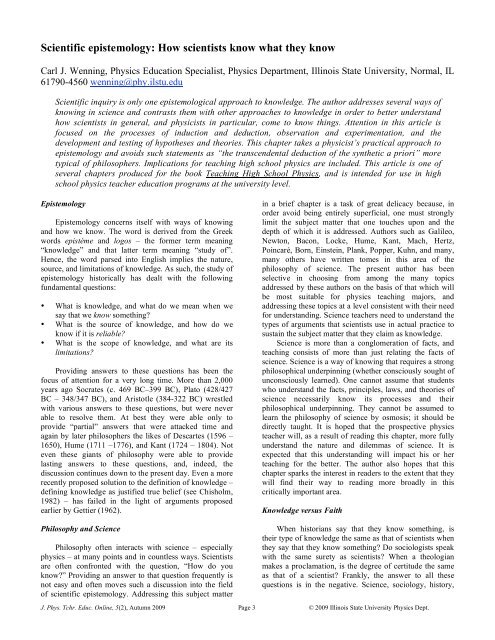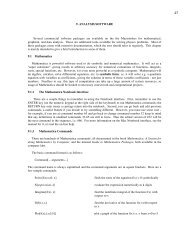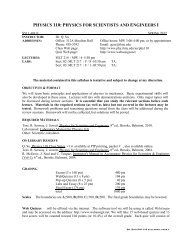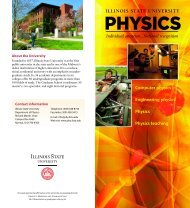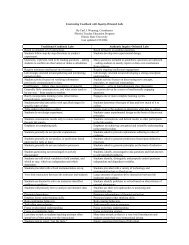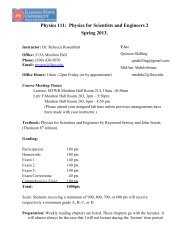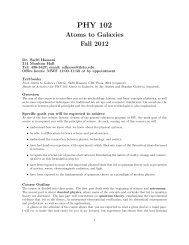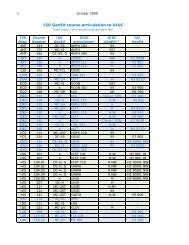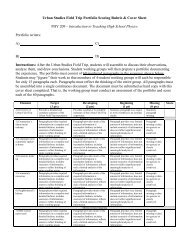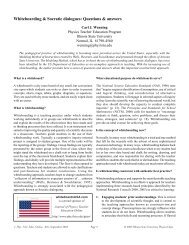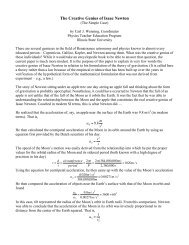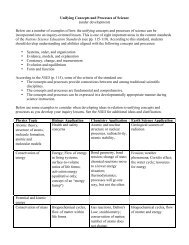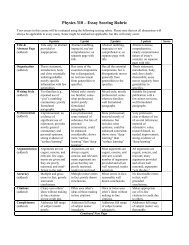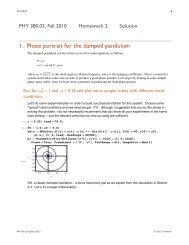Scientific epistemology: How scientists know what they know
Scientific epistemology: How scientists know what they know
Scientific epistemology: How scientists know what they know
Create successful ePaper yourself
Turn your PDF publications into a flip-book with our unique Google optimized e-Paper software.
<strong>Scientific</strong> <strong>epistemology</strong>: <strong>How</strong> <strong>scientists</strong> <strong>know</strong> <strong>what</strong> <strong>they</strong> <strong>know</strong><br />
Carl J. Wenning, Physics Education Specialist, Physics Department, Illinois State University, Normal, IL<br />
61790-4560 wenning@phy.ilstu.edu<br />
<strong>Scientific</strong> inquiry is only one epistemological approach to <strong>know</strong>ledge. The author addresses several ways of<br />
<strong>know</strong>ing in science and contrasts them with other approaches to <strong>know</strong>ledge in order to better understand<br />
how <strong>scientists</strong> in general, and physicists in particular, come to <strong>know</strong> things. Attention in this article is<br />
focused on the processes of induction and deduction, observation and experimentation, and the<br />
development and testing of hypotheses and theories. This chapter takes a physicist’s practical approach to<br />
<strong>epistemology</strong> and avoids such statements as “the transcendental deduction of the synthetic a priori” more<br />
typical of philosophers. Implications for teaching high school physics are included. This article is one of<br />
several chapters produced for the book Teaching High School Physics, and is intended for use in high<br />
school physics teacher education programs at the university level.<br />
Epistemology<br />
Epistemology concerns itself with ways of <strong>know</strong>ing<br />
and how we <strong>know</strong>. The word is derived from the Greek<br />
words epistéme and logos – the former term meaning<br />
“<strong>know</strong>ledge” and that latter term meaning “study of”.<br />
Hence, the word parsed into English implies the nature,<br />
source, and limitations of <strong>know</strong>ledge. As such, the study of<br />
<strong>epistemology</strong> historically has dealt with the following<br />
fundamental questions:<br />
• What is <strong>know</strong>ledge, and <strong>what</strong> do we mean when we<br />
say that we <strong>know</strong> something?<br />
• What is the source of <strong>know</strong>ledge, and how do we<br />
<strong>know</strong> if it is reliable?<br />
• What is the scope of <strong>know</strong>ledge, and <strong>what</strong> are its<br />
limitations?<br />
Providing answers to these questions has been the<br />
focus of attention for a very long time. More than 2,000<br />
years ago Socrates (c. 469 BC–399 BC), Plato (428/427<br />
BC – 348/347 BC), and Aristotle (384-322 BC) wrestled<br />
with various answers to these questions, but were never<br />
able to resolve them. At best <strong>they</strong> were able only to<br />
provide “partial” answers that were attacked time and<br />
again by later philosophers the likes of Descartes (1596 –<br />
1650), Hume (1711 –1776), and Kant (1724 – 1804). Not<br />
even these giants of philosophy were able to provide<br />
lasting answers to these questions, and, indeed, the<br />
discussion continues down to the present day. Even a more<br />
recently proposed solution to the definition of <strong>know</strong>ledge –<br />
defining <strong>know</strong>ledge as justified true belief (see Chisholm,<br />
1982) – has failed in the light of arguments proposed<br />
earlier by Gettier (1962).<br />
in a brief chapter is a task of great delicacy because, in<br />
order avoid being entirely superficial, one must strongly<br />
limit the subject matter that one touches upon and the<br />
depth of which it is addressed. Authors such as Galileo,<br />
Newton, Bacon, Locke, Hume, Kant, Mach, Hertz,<br />
Poincaré, Born, Einstein, Plank, Popper, Kuhn, and many,<br />
many others have written tomes in this area of the<br />
philosophy of science. The present author has been<br />
selective in choosing from among the many topics<br />
addressed by these authors on the basis of that which will<br />
be most suitable for physics teaching majors, and<br />
addressing these topics at a level consistent with their need<br />
for understanding. Science teachers need to understand the<br />
types of arguments that <strong>scientists</strong> use in actual practice to<br />
sustain the subject matter that <strong>they</strong> claim as <strong>know</strong>ledge.<br />
Science is more than a conglomeration of facts, and<br />
teaching consists of more than just relating the facts of<br />
science. Science is a way of <strong>know</strong>ing that requires a strong<br />
philosophical underpinning (whether consciously sought of<br />
unconsciously learned). One cannot assume that students<br />
who understand the facts, principles, laws, and theories of<br />
science necessarily <strong>know</strong> its processes and their<br />
philosophical underpinning. They cannot be assumed to<br />
learn the philosophy of science by osmosis; it should be<br />
directly taught. It is hoped that the prospective physics<br />
teacher will, as a result of reading this chapter, more fully<br />
understand the nature and dilemmas of science. It is<br />
expected that this understanding will impact his or her<br />
teaching for the better. The author also hopes that this<br />
chapter sparks the interest in readers to the extent that <strong>they</strong><br />
will find their way to reading more broadly in this<br />
critically important area.<br />
Knowledge versus Faith<br />
Philosophy and Science<br />
Philosophy often interacts with science – especially<br />
physics – at many points and in countless ways. Scientists<br />
are often confronted with the question, “<strong>How</strong> do you<br />
<strong>know</strong>?” Providing an answer to that question frequently is<br />
not easy and often moves such a discussion into the field<br />
of scientific <strong>epistemology</strong>. Addressing this subject matter<br />
When historians say that <strong>they</strong> <strong>know</strong> something, is<br />
their type of <strong>know</strong>ledge the same as that of <strong>scientists</strong> when<br />
<strong>they</strong> say that <strong>they</strong> <strong>know</strong> something? Do sociologists speak<br />
with the same surety as <strong>scientists</strong>? When a theologian<br />
makes a proclamation, is the degree of certitude the same<br />
as that of a scientist? Frankly, the answer to all these<br />
questions is in the negative. Science, sociology, history,<br />
J. Phys. Tchr. Educ. Online, 5(2), Autumn 2009 Page 3 © 2009 Illinois State University Physics Dept.
and religion each have their own ways of <strong>know</strong>ing and<br />
different types of certitude.<br />
One fundamental question with which all <strong>scientists</strong><br />
ultimately must reckon is how <strong>they</strong> actually <strong>know</strong><br />
anything. Consider for instance the following statements:<br />
• The Earth is a spheroid.<br />
• The Earth spins daily on its axis.<br />
• The Earth orbits the Sun annually.<br />
Most readers will agree with these assertions, but how<br />
many of them actually <strong>know</strong> that the Earth is a spheroid,<br />
spins daily upon its axis, and orbits the Sun annually? Do<br />
<strong>they</strong> <strong>know</strong> these statements to be correct, or do <strong>they</strong> merely<br />
have faith that <strong>they</strong> are correct? The fact of the matter is<br />
that the vast majority of even physics majors will not <strong>know</strong><br />
the basis for these statements that took <strong>scientists</strong> many<br />
years to develop. The facts underlying these<br />
understandings are by no means clear. Indeed, the<br />
philosopher-scientist Aristotle argued so eloquently against<br />
the motion of the Earth that his reasoning held sway for<br />
nearly two millennia. He argued that if the Earth were<br />
spinning we should feel the motion, encounter prevailing<br />
easterly winds, see the oceans cast off at the equator, and<br />
find that projectiles are left behind when thrown into the<br />
air – yet we see none of these! So, on <strong>what</strong> basis do<br />
current <strong>scientists</strong> make the above three claims? <strong>How</strong> do<br />
<strong>they</strong> <strong>know</strong> the answers; how do <strong>they</strong> justify their beliefs?<br />
If a person claims to <strong>know</strong> something rather than<br />
merely have faith in something, then that person should be<br />
able to provide evidence to support the claim. If there is no<br />
support for the claim, then one has mere faith and not<br />
<strong>know</strong>ledge. Anyone who claims to <strong>know</strong> something should<br />
always be ready, willing, and able to answer the question,<br />
“<strong>How</strong> do you <strong>know</strong>?” Scientists – as should all science<br />
teachers – must always be watchful of embracing<br />
unjustified beliefs for in doing so <strong>they</strong> are merely<br />
embracing opinion. According to Blaise Pascal, “Opinion<br />
is the mistress of error; she cannot make us wise, only<br />
content.”<br />
The Nature of Knowledge<br />
What then is <strong>know</strong>ledge? It appears that <strong>know</strong>ledge is<br />
to some extent a justified belief. In the not too distant past<br />
efforts were made to expand upon this definition by<br />
including an additional qualifier as in justified true belief<br />
Chisholm, 1982). Such a definition stated that we <strong>know</strong> X<br />
if, and only if,<br />
X is true;<br />
We believe X; and<br />
We are justified in believing X.<br />
Let’s look at an example by considering the following<br />
argument:<br />
• We believe that when someone jumps out of an open<br />
window, the person falls to the ground.<br />
• We are justified in believing that when someone<br />
jumps out of an open window, the person falls to the<br />
ground.<br />
The first statement clearly has been the case since<br />
windows were invented or one can legitimately make that<br />
argument. <strong>How</strong>ever, might one not be equally justified in<br />
saying that someone who jumps out of an open window<br />
will fall to the ground until next Tuesday at noon after<br />
which time people will then fall into the sky? The<br />
inferential process based on experience could support both<br />
claims unless one makes a presumption about the nature of<br />
the world: the laws of nature are forever constant and<br />
apply the same way to all matter across both time and<br />
space.<br />
This view is <strong>know</strong>n as the Uniformity of Nature<br />
Principle, and is one upon which all science and <strong>scientists</strong><br />
rely. It is based on a long human record of experiences<br />
with nature, and is supported even in our observations of<br />
outer space that show the same physical principles in<br />
operation over the entire universe and throughout the<br />
distant past.<br />
<strong>How</strong> We Know in General<br />
There are several ways of <strong>know</strong>ing things in general,<br />
but not all ways would be considered “scientific.”<br />
Sociologists, historians, and theologians <strong>know</strong> things in<br />
ways quite different from that of <strong>scientists</strong>. Sociologist<br />
might refer to surveys and draw conclusions from<br />
demographic data. Historians might refer to primary<br />
sources such as written documents, photographs, and<br />
eyewitnesses; theologians might rely on scripture<br />
considered inspired or the word of God or on the work of a<br />
highly distinguished theologian. Scientists, however,<br />
would not make these sorts of claims as no scientist or<br />
scientific writing is considered the ultimate authority. All<br />
paths to <strong>know</strong>ledge, however, do apply human reason to a<br />
greater or lesser extent as a generic way of <strong>know</strong>ing.<br />
Rationalism<br />
Adherents of rationalism believe that logic is the<br />
source of <strong>know</strong>ledge. Syllogisms, one form of logic, can be<br />
used to derive <strong>know</strong>ledge if applied properly. Here we use<br />
a form of syllogism <strong>know</strong>n to logicians as “modus ponens”<br />
reasoning. (There is an opposite form logical construct not<br />
dissimilar to this <strong>know</strong>n as the “modus tollens” that denies<br />
a particular conclusion, but it will not be dealt with here.)<br />
The modus ponens syllogism takes the following form.<br />
If A, then B;<br />
A;<br />
Therefore, B.<br />
• When someone jumps out of an open window, the<br />
person falls to the ground.<br />
The first step of this logical argument is called the<br />
major premise; the second step is the minor premise; the<br />
third step is the conclusion. Consider the following<br />
J. Phys. Tchr. Educ. Online, 5(2), Autumn 2009 Page 4 © 2009 Illinois State University Physics Dept.
argument that illustrates the modus ponens type of logical<br />
argument. If humans are cut, <strong>they</strong> will bleed. I am human.<br />
Therefore, when I am cut I will bleed. Sounds reasonable.<br />
But <strong>what</strong> is the problem with the following argument?<br />
when we pre-judge someone or something on the basis of<br />
prior impressions. With all these critiques of pure reason,<br />
how can anyone actually ever <strong>know</strong> anything using the<br />
approach of rationalism alone?<br />
• If I can locate the North Star, I can use it to find north<br />
at night.<br />
• I can locate the North Star because it is the brightest<br />
star in the night sky.<br />
• Therefore, the brightest star in the night sky shows the<br />
direction north.<br />
Many people will agree with the conclusion of this<br />
statement. If you are skeptical, go out and try this line of<br />
reasoning on a number of people. You will be amazed with<br />
how many will find the argument and conclusion perfectly<br />
acceptable. The problem with this statement, as you may<br />
well <strong>know</strong>, is that the conclusion is completely wrong. The<br />
major premise is correct; the minor premise is a broadly<br />
held misconception that leads to an incorrect conclusion.<br />
The North Star, Polaris, is the 49 th brightest star in the<br />
night sky. Sirius, the Dog Star, is the brightest star in the<br />
night sky. Sirius rises roughly in the southeast and sets in<br />
roughly the southwest for observers in the mid northern<br />
latitudes where the North Star is plainly visible about half<br />
way up in the northern sky. Sirius is likely to “point”<br />
southeast or southwest near its rising and setting<br />
respectively, and south only when it is highest in the sky.<br />
Scientists tend to avoid the syllogistic approach to<br />
<strong>know</strong>ledge, as it is “empty”. The conclusion cannot state<br />
more than <strong>what</strong> has been noted in the premises, and thus<br />
only makes explicit <strong>what</strong> has been stated previously.<br />
Reason alone, without the support of evidence, is quite<br />
limited and subject to error. For example, consider the<br />
claim by Aristotle that heavier objects fall faster than<br />
lighter objects. This makes perfect sense in light of natural<br />
human reason. If a larger force is applied to an object, it<br />
accelerates at a higher rate. Now, if the earth is pulling on<br />
one object more than another, doesn’t it make logical sense<br />
that the heavier object should fall faster? But despite<br />
human reason, experimental evidence shows that this is<br />
wrong. Barring friction, all objects accelerate at the same<br />
rate independent of their weight. If Aristotle had only<br />
<strong>know</strong>n about Newton’s second law, he would have<br />
understood that greater mass requires greater force to<br />
accelerate it thus canceling the “advantage” of weight over<br />
mass. Another example of the failure of reason can be<br />
exhibited in responding to the question, “What is the<br />
weight of smoke?” One might weigh an object before<br />
burning it and then measure the weight of the ashes. The<br />
difference between the two is the weight of the smoke. The<br />
process fails because it does not take into account the<br />
addition of oxygen from the air when it enters into the<br />
burning process.<br />
We must keep in mind that one’s outlook as well as<br />
lack of understanding can sway reason. As anyone who<br />
has examined the religious and political arenas will be<br />
aware, we tend to believe <strong>what</strong> we want to believe, and<br />
take facts as opinions if we do not agree, and opinions as<br />
facts if we do agree. We sometimes gain false impressions<br />
Reliabilism<br />
Adherents of reliabilism say that <strong>they</strong> are justified in<br />
<strong>know</strong>ing something only if that something is arrived at<br />
using a reliable cognitive process that extends beyond<br />
mere human reason. Less subjective than human reason<br />
and not subject to self-deception or human bias is artificial<br />
inference such as the rules of mathematics or Boolean<br />
logic. These are ideal approaches for deriving <strong>know</strong>ledge.<br />
Structured logic is the sine qua non of reliabilists.<br />
Consider for instance, the following <strong>know</strong>ledge derived<br />
from the axiomatic proofs of mathematics. From the<br />
relationship 4x + 2 = 10 one can follow the rules of algebra<br />
to reliably conclude that x = 2. No question about it. But<br />
<strong>what</strong> can we conclude from the following manipulation<br />
where x is a variable and c a constant?<br />
J. Phys. Tchr. Educ. Online, 5(2), Autumn 2009 Page 5 © 2009 Illinois State University Physics Dept.<br />
x = c<br />
x 2 = cx<br />
x 2 – c 2 = cx – c 2<br />
(x + c)(x – c) = c(x – c)<br />
x +c = c<br />
2c = c<br />
2 = 1<br />
Now, multiply each side by x.<br />
Next, subtract c 2 from each side.<br />
Factor.<br />
Cancel the common term (x – c).<br />
Substitute c for x and combine.<br />
Cancel the common term c.<br />
Now, does 2 really equal 1? Of course not. But why<br />
not? Clearly, we have arrived at a false conclusion because<br />
we have violated one of the rules of algebra. Can you tell<br />
which one? The point is that if a person is using artificial<br />
inference to derive <strong>know</strong>ledge, one must be exceedingly<br />
careful not to broach any of the rules of mathematics and<br />
logic – assuming that all are actually <strong>know</strong>n.<br />
Coherentism<br />
Adherents of coherentism believe that <strong>know</strong>ledge is<br />
secure when its ideas support one another to form a logical<br />
construct, much like bricks and mortar of a building<br />
supporting one another to form an edifice. Knowledge is<br />
certain only when it coheres with similar information. To<br />
this means of <strong>know</strong>ing, universal consent can prove to be<br />
fruitful. According to the coherentist viewpoint, because<br />
“everyone” believes something that it must be so.<br />
No one in their right mind would dispute the<br />
statements that Indiana is located between Ohio and<br />
Illinois, and that the Eiffel Tower is located in Paris. Many<br />
there are who have traveled to Indiana and Paris and <strong>know</strong><br />
from personal experience the locations of the state and the<br />
tower. Besides, there are books and maps and internet
eferences that all say the same thing. Everyone and<br />
everything, it seems, agrees with these statements. But be<br />
careful. Just because “everyone” believes something,<br />
doesn’t necessarily make it so. It was once believed by<br />
nearly everyone that diseases resulted from humans having<br />
displeasured the gods, that the Earth was flat, and that the<br />
Earth stood unmoving at the center of the universe.<br />
Coherentism lends itself to yet another way of<br />
<strong>know</strong>ing that can be similarly flawed, that of perfect<br />
credibility. To the medieval mind it was only reasonable<br />
that the Earth was at the center of the universe, the lowest<br />
point possible under the heavens. To medieval thinkers<br />
humanity was at the center of the universe not because of<br />
our noble status as the pinnacle of creation, but because we<br />
were so very despicable with our fallen nature. Closer to<br />
the center of the universe still was that place at the very<br />
center of the Earth that was reserved for the most<br />
despicable of all – hell. Those not so terribly bad were<br />
relegated to the underworld or Hades upon death, but not<br />
hell. This is the reason why the medieval viewpoint<br />
envisioned heaven as “up” and hell as “down.” Man’s<br />
position near or at the center of the universe was not pride<br />
of place; rather, it was a matter of making perfect sense in<br />
man’s relationship with the deities. This belief was<br />
perfectly credible. Interpreting things in any other way<br />
would have made no sense given the then prevailing<br />
theological understanding. Still, such conclusions were<br />
flawed. Remember, all Aristotle’s evidence and<br />
argumentation at one time pointed to the fact that the Earth<br />
was stationary, but today we <strong>know</strong> that it spins daily upon<br />
it axis and revolves annually around the Sun which is just<br />
one of billions of stars located in a typical galaxy, one of<br />
billions seemingly scattered almost entirely at random<br />
around a universe that has no evident center.<br />
Credible authority is another way of <strong>know</strong>ing based<br />
on coherentism, and it is the way that almost everyone has<br />
come to “<strong>know</strong>” <strong>what</strong> <strong>they</strong> claim <strong>know</strong> about the universe.<br />
It is this approach that is often used in schools to teach<br />
children. The teacher is the authority figure; the children<br />
are empty vessels to be filled with “<strong>know</strong>ledge”. While<br />
this viewpoint is quite wrong, it does have its uses – and<br />
also its limitations. Let’s look at the following questions.<br />
What is your name? <strong>How</strong> do you <strong>know</strong>? Is Labor Day a<br />
legal holiday in the USA? <strong>How</strong> do you <strong>know</strong>? You <strong>know</strong><br />
your name because those entitled to name you at birth,<br />
your parents, did so. They are credible authorities as only<br />
parents have a right to name their children. We <strong>know</strong> that<br />
Labor Day is a national holiday because the United States<br />
Congress declared by law that it should be so in 1894. By<br />
their legal authority, parents and Congress have performed<br />
an act by the very power vested in them. Relying entirely<br />
on this approach to <strong>know</strong>ing can be problematic in many<br />
situations as not all authorities are credible. For instance,<br />
many religious sects claiming to possess the “truth” preach<br />
contradictory beliefs; <strong>they</strong> can’t all be correct. Psychics<br />
might intentionally make false claims in order to influence<br />
the direction of lives. Financial consultants might seek to<br />
mislead clients in an effort to achieve financial gain.<br />
There are several unresolved problems associated with<br />
coherentism. When ideas or beliefs conflict, it is not<br />
possible to tell which one is to be accepted. <strong>How</strong> do we<br />
distinguish a correct idea from an incorrect idea when<br />
incorrect ideas sometimes are consistent with <strong>what</strong> we<br />
already <strong>know</strong>, or a new idea conflicts with <strong>what</strong> we<br />
“<strong>know</strong>” to be correct? <strong>How</strong> do we distinguish a better or<br />
more important idea from one less so? What role does bias<br />
play a role in our ability to distinguish correctly?<br />
Coherentism, it appears, is unable to provide meaningful<br />
answers to these questions.<br />
Empiricism<br />
Adherents of classical empiricism (a type of<br />
empiricism perhaps best suited to teaching high school<br />
physics) believe that logic, connected to verification<br />
though observation or experimentation, leads to<br />
<strong>know</strong>ledge. The empirical approach to <strong>know</strong>ledge consists<br />
of reason constrained by physical evidence. For example,<br />
reason in conjunction with observation helps <strong>scientists</strong><br />
<strong>know</strong> that the Earth is spheroidal. Careful observers will<br />
note that the North Star descends below the northern<br />
horizon for travelers crossing from north to south of the<br />
equator at any longitude, that the masts of ships disappear<br />
long after the hull when ships travel over the horizon in<br />
any direction, circumnavigation of the globe being<br />
possible in any direction, and the shadow of the Earth on<br />
the moon during a lunar eclipse at any time of night are all<br />
pieces of evidence that one can logically use to conclude<br />
that the Earth is roughly spherical. Observation in<br />
conjunction with reason will lead to no other conclusion.<br />
In its simplest form, one might <strong>know</strong> something<br />
through personal experience. If one’s hand is burned by a<br />
hot piece of metal, one <strong>know</strong>s it and has the evidence to<br />
prove it. One’s hand might be red and painful as with a<br />
first degree burn, or there might be blisters with<br />
excruciating pain as with a second degree burn, or there<br />
might even be charred flesh with an acrid smell as in a<br />
third degree burn. One’s belief is substantiated with<br />
evidence; hence, one can support a belief with evidence.<br />
One’s belief in a burned hand is not merely a matter of<br />
faith; one actually possesses <strong>know</strong>ledge based on reason<br />
sustained by ample evidence. One must be careful,<br />
however, of assuming that personal experience is the final<br />
arbiter of whether or not an experience provides<br />
incontrovertible evidence. Some concrete experiences can<br />
be interpreted or viewed in different ways. The failure of<br />
eyewitnesses to provide identical interpretations is a good<br />
example of this. In the case of a robbery, the person who<br />
has a gun shoved into his or her face might remember<br />
things about the perpetrator of the crime quite differently<br />
from someone who witnessed the act from a hidden<br />
location. One’s perspective can, indeed, influence <strong>what</strong><br />
one sees or remembers, or how one interprets evidence.<br />
People don’t always draw the same conclusion based on<br />
the same evidence either. In the case of the traditional “boy<br />
who called wolf” story, two conclusions can be drawn –<br />
either don’t lie, or don’t tell the same lie more than once!<br />
Improvements in technology can lead to increased<br />
precision in observations. Refined observations can then<br />
lead to overturning <strong>know</strong>ledge based on reason and new<br />
J. Phys. Tchr. Educ. Online, 5(2), Autumn 2009 Page 6 © 2009 Illinois State University Physics Dept.
observations. The history of science is littered with<br />
evidence-based models now discarded that were once<br />
thought to constitute <strong>know</strong>ledge. A review of the history of<br />
scientific models – the solar system, evolution, the atom,<br />
the nature and origin of the universe, the nature and cause<br />
of gravitation, predator-prey relationships, genetics, heat<br />
and energy – all point to the fact that <strong>scientists</strong> spend a<br />
great deal of time building, testing, comparing and revising<br />
models in light of new evidence.<br />
As history shows, even scientific <strong>know</strong>ledge is<br />
tentative. This is so for more than one reason: (1) <strong>scientists</strong><br />
presume the Uniformity of Nature principle and to the<br />
extent that this presumption is wrong, our conclusions<br />
based upon it are similarly wrong; and (2) <strong>what</strong> is accepted<br />
at any one point in time by the converged opinion of<br />
institutional science is <strong>what</strong> constitutes established<br />
scientific <strong>know</strong>ledge. Borrowing a page from the book of<br />
coherentism, when all the indicators suggest that<br />
something is correct, it is assumed to be so until new<br />
empirical evidence overrules it. Scientists therefore do not<br />
claim to possess “truth” as such because this would<br />
constitute something that is <strong>know</strong>n now and forever to be<br />
correct, and totally consistent with reality. To make a<br />
claim of possessing “truth” would be worse than<br />
presumptuous.<br />
This is not to say that scientific <strong>know</strong>ledge is “weak”.<br />
The vast majority of <strong>what</strong> we teach in high school science<br />
– especially physics – is not likely to change. Quite the<br />
contrary. Our understanding of momentum, energy, optics,<br />
electricity, magnetism, and such, is extremely well<br />
supported and there is no reason to believe that it ever<br />
should change. It is for this reason that <strong>scientists</strong> say <strong>they</strong><br />
their <strong>know</strong>ledge is tentative, while at the same time<br />
durable.<br />
Induction, Deduction, and Abduction<br />
Induction and deduction are at the heart of<br />
empiricism. In the process of induction, one generalizes<br />
from a set of specific cases; in the process of deduction,<br />
one generates specifics from a general rule. Induction can<br />
be thought of as a search for generality; deduction can be<br />
thought of as a search for specificity. A very simple<br />
example will suffice to explain the concepts of induction<br />
and deduction.<br />
Suppose a person goes to a roadside fruit stand<br />
wanting to buy sweet apples. The fruit stand owner offers<br />
up some slices of apples as samples. Taking a bite of one<br />
sample our shopper finds that it is sour. He examines the<br />
apple and sees that it is hard and green. He then takes<br />
another sample and finds that it too is hard, green, and<br />
sour. Before picking a third sample our shopper observes<br />
that all the apples are hard and green. He departs having<br />
decided not to buy any apples from this fruit stand<br />
concluding <strong>they</strong> are all sour.<br />
Granted, two samples is a very minimal basis for<br />
performing induction, but it suffices for this example. If<br />
one were to examine the thought process that was used by<br />
our would-be buyer, one would determine that this is how<br />
he reasoned:<br />
All hard and green apples are sour;<br />
these apples are all hard and green;<br />
therefore, these apples are all sour.<br />
We have seen this form of reasoning before and<br />
recognize it as a modus ponens form of syllogism. Our<br />
shopper has performed an inductive process that relied on<br />
specific cases of evidence to generate a general rule. Note<br />
then the next lines of the shopper’s reasoning:<br />
Because all of the apples are sour,<br />
I do not want to purchase any of these apples.<br />
When the shopper decides to depart the fruit stand<br />
without purchasing any apples he does so on the basis of<br />
deduction. Using the conclusion established via induction,<br />
he made a decision via deduction to leave without<br />
purchasing any apples.<br />
Scientists rarely use the syllogistic process when <strong>they</strong><br />
deal with the subject matter of science because <strong>they</strong> are not<br />
interested in drawing “empty conclusions” about material<br />
objects. For instance, “All light travels in straight lines; we<br />
have light; therefore, <strong>what</strong> we have is traveling in straight<br />
lines” contributes nothing to scientific <strong>know</strong>ledge or<br />
understanding. To justify the claim that light travels in<br />
straight lines we must make observations that lead<br />
observers to this conclusion. Data related to the<br />
phenomenon must be accounted for in terms of this<br />
principle.<br />
Abduction is at the heart of generating explanations in<br />
science. It is the process of creating hypotheses. The<br />
formulation of hypotheses – constructs designed to provide<br />
predictions and explanations – begins with examination of<br />
available evidence and devising an explanation for it.<br />
Abduction sometimes relies upon analogies with other<br />
situations. In the previous example, one might conclude<br />
from <strong>know</strong>ledge that sugar gives the taste of sweetness to<br />
those things that contain it, that natural sugars are absent in<br />
hard green apples. This would explain the lack of<br />
sweetness in the apples sampled at the fruit stand. The<br />
statement that hard green apples are sour because <strong>they</strong> lack<br />
natural sugars present in sweet apples is a hypothesis<br />
derived by abduction. They hypothesis serves to explain<br />
why the samples of hard green apples all tasted sour.<br />
Some authors have falsely claimed that hypotheses are<br />
generated from the processes of induction. This is<br />
incorrect. Inductive processes can only provide general<br />
statements and, as such, cannot explain anything. The<br />
relationships between induction, deduction, and abduction<br />
are shown in Table 1.<br />
Intellectual processes and their connections to science<br />
Induction is most closely related to the generation of<br />
principles and laws in science. Principles identify general<br />
relationships between variables such as “When water is<br />
heated in an open container, it evaporates.” Laws identify<br />
specific relationship between certain observable quantities<br />
such as “The period of a pendulum is proportional to the<br />
J. Phys. Tchr. Educ. Online, 5(2), Autumn 2009 Page 7 © 2009 Illinois State University Physics Dept.
square root of its length.” Principles and laws are<br />
descriptive, and almost without exception can be stated in<br />
a single formulation, and have no explanatory power.<br />
Laws and principles are established on the basis of direct<br />
evidence. Principles and laws are resilient because <strong>they</strong> are<br />
based directly on observational evidence and not upon a<br />
hypothesis or theory. Even when a hypothesis or theory<br />
that explains them is proven false (e.g., Wien’s<br />
displacement law with the failings of classical<br />
electrodynamics, Balmer’s spectral law in the light of the<br />
failed Bohr model), principles and laws survive the demise<br />
of the hypothesis or theory.<br />
Deduction is most closely related to the generation of<br />
predictions in science – the process of using principles,<br />
laws, hypotheses, or theories to predict some observational<br />
quantity under certain specified conditions.<br />
Abduction is most closely related to the generation of<br />
hypotheses in science – tentative explanations that almost<br />
always consist of system of several conceptual statements.<br />
A hypothesis, because it often deals with unobservable<br />
elements, often cannot be directly tested via experiment.<br />
An example of this would be electron theory that notes that<br />
electrons are carriers of an elementary charge, the<br />
assumption of which served as the basis of the Millikan<br />
oil-drop experiment. Sometimes, the sole basis for<br />
accepting hypotheses is their ability to explain laws, make<br />
predictions, and provide explanations. For instance,<br />
Newton’s formulation of gravity was accepted on the basis<br />
that it was able to account for Kepler’s three laws of<br />
planetary motion. So it was with Copernican theory, the<br />
corpuscular theory of light, atomic theory of the Periodic<br />
Table, and the kinetic theory of gases. Bohr’s model for<br />
the atom and Einstein’s special and general theories were<br />
similarly accepted on the basis of their ability to make<br />
accurate predictions and provide explanations.<br />
Table 1. Connections between intellectual processes and<br />
scientific nomenclature.<br />
Induction in Science<br />
!<br />
Central to the inductive process in science is<br />
observation. Observation is key to many sciences.<br />
Biologists, for instance, learn about the lives and behaviors<br />
of animals by making observations. They accumulate a<br />
large amount of data about, say, gorillas, and how <strong>they</strong><br />
interact under certain conditions. Geologists likewise<br />
collect data by studying minerals and maps, examining<br />
rock formations, and reviewing earthquake data from their<br />
seismographs. Meteorologists similarly collect data about<br />
the weather such as temperature, barometric pressure,<br />
relative humidity, wind speed and direction, and so forth.<br />
Scientists do not stop there, however. Raw data per se are<br />
of little use, and no scientific journal will publish long lists<br />
of data. Scientists are not merely “cameras” expected to<br />
record data (Bronowski, 1965). Rather, it is only when<br />
<strong>they</strong> synthesize conclusions based on observations that<br />
<strong>they</strong> are doing the work of <strong>scientists</strong>. (See sidebar story 1.)<br />
SIDEBAR STORY 1<br />
Induction and the Genius of Isaac Newton<br />
Isaac Newton (1643-1727, Julian calendar) used<br />
induction as the basis of <strong>what</strong> is <strong>know</strong>n today as his theory<br />
of gravitation. Now, the story of Newton sitting under an<br />
apple tree seeing an apple fall and thinking about the form<br />
of gravitation is probably apocryphal. Nonetheless, it could<br />
have occurred to Newton that the fall of an apple is not<br />
unlike the fall of the Moon as it orbits the Earth. It was the<br />
fact that he was able to understand the relationship<br />
between the Moon’s and the apple’s acceleration that<br />
constitutes the genius of Isaac Newton. Couched in<br />
modern SI terms, and using the simplifying assumption of<br />
circular motion, this is <strong>what</strong> Newton did. First, he realized<br />
that the acceleration of, say, an apple near the surface of<br />
the Earth was<br />
a " = 9.8 m s 2<br />
He then calculated the centripetal acceleration of the Moon<br />
in its orbit around the Earth by using an equation first<br />
provided by the ! Dutch <strong>scientists</strong> of his day:<br />
a " = v 2<br />
The speed of the Moon’s motion was easily derived from<br />
the relationship into which he put the proper values for the<br />
orbital radius of ! the Moon and its orbital period (both<br />
<strong>know</strong>n with a relatively high degree of precision in<br />
Newton’s day)<br />
v = d t = circumference<br />
period<br />
r<br />
= 2"r<br />
P = 2" (3.84 x108 m)<br />
= 1020m /s<br />
2,360,000s<br />
Using the equation for centripetal acceleration, he then<br />
came up with the value of the Moon’s acceleration<br />
a " =<br />
(1020m /s)2<br />
= 0.00271m /s2<br />
384,000,000m<br />
He then compared the acceleration of objects near the<br />
Earth’s surface with that of the Moon in orbit and found<br />
!<br />
a " 9.8m /s 2<br />
=<br />
a # 0.00271m /s 2 = 3600<br />
He then realized that 3600 could well represent the ratio of<br />
the Moon’s orbital radius to the Earth radius squared.<br />
!<br />
J. Phys. Tchr. Educ. Online, 5(2), Autumn 2009 Page 8 © 2009 Illinois State University Physics Dept.
a $<br />
"<br />
= 60 2 = r '<br />
#<br />
& )<br />
a # % (<br />
From this formulation, Newton surmised that the<br />
acceleration of an object (be it the Moon or an apple) is<br />
inversely proportional ! to its distance from the center of the<br />
Earth squared (and perhaps where he first realized that the<br />
Earth acts as though all its mass is concentrated in a point<br />
at its center). That is,<br />
a " 1<br />
r 2<br />
Given the fact that F = ma, Newton concluded that the<br />
force required to hold the Moon in its orbit around the<br />
Earth was also dependent ! upon the mass of the moon, m.<br />
That is,<br />
F " m r 2<br />
Because gravity is responsible for the perceived weight of<br />
objects, and would likely be proportional to the mass of the<br />
Earth, M, as well ! as the moon, Newton further<br />
hypothesized that,<br />
F " Mm<br />
r 2<br />
Inserting the proportionality constant, k, gave Newton his<br />
final formulation for the force due to gravity.<br />
!<br />
F = k Mm<br />
r 2<br />
It wasn’t until the 1797-1798 experimental work of Henry<br />
Cavendish (1731-1810) that the value of k was determined.<br />
Once he did so, ! the k was replaced with a G giving us the<br />
now familiar expression<br />
F = GMm<br />
r 2<br />
So, it should be evident from this work of induction<br />
that Newton’s act of creative genius was in the fact that he<br />
was able to use ! observational evidence to formulate a<br />
relationship to determine the nature of the central force<br />
required to keep objects in orbital motion. Edmund Halley<br />
(1646-1742) used Newton’s formulation of gravity and<br />
observations of an earlier bright comet to predict its return.<br />
That comet, now named Halley’s Comet, returned as<br />
predicted in the year 1758. Later Urbain Leverrier (1811-<br />
1877) and John Couch Adams (1819-1892) independently<br />
used Newton’s formulation of gravity to analyze the<br />
irregular motions of the planet Uranus, and predict the<br />
location of a hitherto un<strong>know</strong>n planet – Neptune –<br />
r "<br />
2<br />
discovered in 1846. These cases used Newton’s<br />
formulation of the force due to gravity to make predictions<br />
and, as such, are examples of deduction.<br />
Principles and laws are inferences that result from the<br />
generalization of different types of data. Principles are<br />
general relationships between observable properties. As<br />
the day progresses and the land warms, warm air rises over<br />
the land and is replaced by cool breezes that blow from the<br />
sea to the land. We see that when air warms, it expands<br />
and thereby gaining buoyancy. We see that living<br />
organisms require energy in order to survive. We see the<br />
conservation of energy in its many forms. We see that<br />
objects fall to the ground when left unsupported. We<br />
conclude that light travels in straight lines. These are all<br />
principles of science. The empirical laws of science are<br />
more abstract than general principles in the sense that <strong>they</strong><br />
typically incorporate mathematics in their expressions.<br />
Examples of laws in physics are numerous, and would<br />
include such things as the law of levers, the law of pulleys,<br />
the law of mechanical advantage, the laws of kinematics<br />
and dynamics, the laws of thermal expansion, the<br />
conservation laws in mass, energy, and charge, Newton’s<br />
second law of motion, Ohm’s law, the laws for series and<br />
parallel circuits, the thin lens formula, Snell’s law, and the<br />
laws of relating to heat and change of state, Boyle’s law<br />
and the ideal gas law. All relate mathematic variables in<br />
precise ways. These are all “simple” examples of induction<br />
based on experimentation.<br />
There are many examples of more sophisticated forms<br />
of induction where <strong>scientists</strong> have linked areas of physics<br />
to arrive at a new and more meaningful understanding.<br />
Isaac Newton did this by linking motion to force; Michael<br />
Faraday did this by connecting electricity with magnetism;<br />
James Clerk Maxwell did this by unifying<br />
electromagnetism with light; Albert Einstein did this by<br />
interfacing time with space, mass with energy, and force<br />
with geometry. It was the ability of these <strong>scientists</strong> to make<br />
sense of information that gave value to their ideas, and<br />
allow us to call them genius.<br />
Observation and experimentation are central to the<br />
inductive process. But physical laws, primarily those of<br />
classical physics, were initially derived with the use of<br />
experimentation. No amount of observation would have<br />
allowed a casual observer to discover any of the laws<br />
mentioned above. These are empirical relationships based<br />
controlled experimentation.<br />
Deduction in Science<br />
One of the main goals of <strong>scientists</strong> and engineers is to<br />
perform deductive processes. Scientists use inductive<br />
processes to formulate principles, laws, hypotheses, and<br />
theories from which <strong>they</strong> can then deduce predictions. For<br />
example, applications of various empirical laws such as<br />
ΣF = ma, ΔV = IR, and ΔL = αL o ΔT can be used to predict<br />
future situations under certain conditions. One can, given<br />
the force on and mass of a vehicle, predict its acceleration.<br />
J. Phys. Tchr. Educ. Online, 5(2), Autumn 2009 Page 9 © 2009 Illinois State University Physics Dept.
Applying a voltage difference across an electrical network<br />
with a <strong>know</strong>n resistance, one can predict the consequent<br />
current. Heating a particular rod of <strong>know</strong>n length and<br />
composition by a certain amount, one can determine in<br />
advance <strong>what</strong> the change in length will be. Almost every<br />
piece of technology that we have today has been designed<br />
using the deductive process. This is true on a vast scale,<br />
from nanotechnology to an aircraft carrier.<br />
Astronomers are observationalists par excellence and<br />
are very good at applying <strong>what</strong> <strong>they</strong> <strong>know</strong> from Earthbased<br />
studies to deduce <strong>know</strong>ledge about celestial objects.<br />
They cannot bring planets, comets, stars, nebulae, or<br />
galaxies into the laboratory for experimentation. They do,<br />
however, apply principles, laws, hypotheses, and theories<br />
to their observations in order to learn about celestial<br />
objects. For instance, Edwin Hubble was able to use the<br />
distances and motions of remote galaxies to determine the<br />
age of the cosmos. Using variants of the Hertzsprung-<br />
Russell diagram, astronomers were able to deduce how it<br />
is that stars are born, live out their lives, and die even<br />
though the process can take millions or billions of years.<br />
Using the laws of thermodynamics and nuclear theory,<br />
astronomers have been able to discover how it is that stars<br />
operate. Earlier than any of these examples, astronomers<br />
made use of Newton’s universal law of gravitation and<br />
observations of an orbiting moon to deduce the mass of<br />
Jupiter. (See sidebar story 2.)<br />
SIDEBAR STORY 2<br />
Deduction of the Mass of Jupiter<br />
A generation before Newton, Johannes Kepler (1571-<br />
1630) enunciated three planetary laws of motion based<br />
upon observations of the planet Mars made earlier by<br />
Tycho Brahe (1546-1601). Kepler stated these laws<br />
roughly as follows:<br />
1. Planets move in elliptical orbits around the Sun with<br />
the Sun located at one of the foci.<br />
2. The radius arm between a planet and the Sun sweeps<br />
out equal areas in equal time intervals.<br />
3. The period of a planet expressed in years squared<br />
equals the semi-major axis of the orbit expressed in<br />
astronomical units (equal roughly to the average<br />
Earth-Sun distance) cubed. That is,<br />
P 2 = r 3<br />
If the units other than years and astronomical units are<br />
used (e.g., SI units), then the form of the equation would<br />
be expressed as !<br />
P 2 = (constant)r 3<br />
where the value and units of the constant would depend<br />
upon the units employed in the equation’s other variables.<br />
At this point ! Newton, with his second law, the definition<br />
of centripetal acceleration, and his new formulation of<br />
gravity, was able to write<br />
F = ma = mv 2<br />
Substituting for v = ( 2"r P ) and simplifying the two<br />
rightmost components of this equation, Newton arrived at<br />
!<br />
the following relationship<br />
J. Phys. Tchr. Educ. Online, 5(2), Autumn 2009 Page 10 © 2009 Illinois State University Physics Dept.<br />
!<br />
!<br />
r<br />
= k Mm<br />
r 2<br />
P 2 = 4" 2 r 3<br />
kM = (constant)r 3<br />
which is Kepler’s third or harmonic law! Newton’s<br />
formulation of the law of gravity therefore was able to<br />
explain ! the origin of the harmonic law– it’s due to the fact<br />
that gravity is an inverse-squared force. Newton’s<br />
hypothesis then, with this firm underpinning, was on its<br />
way to becoming theory.<br />
It should be noted, too, that Newton’s more detailed<br />
analysis of the central force problem resulted in a<br />
prediction of elliptical motion. That is, when gravitational<br />
force is assumed to drop off with in inverse-square of the<br />
distance, then elliptical motion results. This is precisely<br />
<strong>what</strong> Kepler observed. Newton’s law of gravitation, F =<br />
Gm 1 m 2 /r 2 , was also used to explain Kepler’s law of equal<br />
areas. These derivations are beyond the scope of this book,<br />
but provide additional bases that led to the universal<br />
acceptance of his formulation of the law of gravitational<br />
force.<br />
Note that the above formulation of Kepler’s harmonic<br />
law is for the simple case that assumes purely circular<br />
motion. In reality, the solar system’s moons and planets<br />
move with barycentric motion. That is, the sun and planets,<br />
the planets and the moons orbit the centers of mass in <strong>they</strong><br />
systems. Taking this consideration into account (and<br />
retaining our assumption of circular motion for<br />
simplicity), Newton was able to derive a more precise form<br />
of the Harmonic law<br />
(M + m)P 2 = 4" 2 (R + r) 3<br />
This relationship later was employed to measure the<br />
masses of various solar system bodies using solar mass<br />
units for ! mass and astronomical units for distance of<br />
measure long before the space age. For instance, if the<br />
mass of a moon of Jupiter, m, is taken to be very small in<br />
relation to the mass of Jupiter, M, and the distance of<br />
Jupiter from its barycenter (R) very small in relation to the<br />
distance of the moon from its barycenter (r), then we can<br />
simplify the above relationship<br />
MP 2 = 4" 2 r 3<br />
k<br />
k<br />
(assuming m
!<br />
M = 4" 2 r 3<br />
GP 2 (assuming m
and given that v " v 0 = at<br />
W = mav 0 t + 1 2 m(v " v 0 )2<br />
W = mav 0 t + 1 2 m(v 2 " 2vv 0 + v 0 2 )<br />
W = mav 0 t + 1 2 mv 2 " mvv 0 + 1 2 mv 0 2<br />
W = mav 0 t + 1 2 mv 2 " m(v 0 + at)v 0 + 1 2 mv 2<br />
0<br />
W = 1 2 mv 2 " mv 2 0 + 1 2 mv 2<br />
0<br />
W = 1 2 mv 2 " 1 2 mv 2<br />
0<br />
W = #E<br />
The working hypothesis that kinematic relationships<br />
hold due to conservation of energy appears to be borne out.<br />
! The fact of the matter is that even the definitions of<br />
acceleration and average velocity shown in the<br />
relationships v = v 0 + at and d " d 0 = v(t " t 0 ) also can be<br />
derived from the work-energy theorem and visa versa, but<br />
these derivations are left for the student. (See the results of<br />
the anticipated student work at the end of this document.)<br />
! The insight that ! conservation of energy is responsible<br />
for the form of kinematic equations is crucial for their<br />
appropriate application. They are valid only so long as<br />
energy is conserved. To the extent that energy is not<br />
conserved in a particular situation (e.g, friction), the<br />
kinematic equations are invalid. While this is a very<br />
simplistic example of the hypothetico-deductive method, it<br />
suffices to show how the process works and to explain<br />
some of the understanding that can be derived from such<br />
an approach.<br />
Perhaps a better example of the formulation of a<br />
hypothesis in physics would be in developing an<br />
explanation of the source of the buoyant force (F B )<br />
experienced by objects immersed in a fluid of density ρ.<br />
Noting that law that states that pressure (p) increases with<br />
depth (p = ρgd), one can calculate the differences in the<br />
forces due to a fluid on the top and bottom surfaces of an<br />
imaginary cube of dimension A (F = pA) at different<br />
depths. This difference in these two forces amounts to the<br />
buoyant force experienced, and can even predict the value<br />
of the buoyant force from the relationship so derived. That<br />
is, F B = ρVg. (See sidebar story 5 in Wenning (2005) for a<br />
detailed explanation.)<br />
Empiricism in Science<br />
<strong>Scientific</strong> <strong>know</strong>ledge is belief based on reason and<br />
empirical evidence; while it is tentative, it is still quite<br />
durable and, in most cases of established science treated in<br />
high school, unlikely to change. A scientific understanding<br />
of nature is an understanding that has been tested against<br />
the empirical evidence that nature provides, and not found<br />
wanting; a scientific law, hypothesis, and theory can be<br />
tested against empirical evidence with the use of<br />
predictions.<br />
Nature itself is the final arbiter in any disagreement<br />
between principles, laws, hypotheses, and theories<br />
developed by <strong>scientists</strong>. Prior to the scientific revolution,<br />
scientific <strong>know</strong>ledge was based upon ancient authorities,<br />
especially Aristotle. Religious dogmas, particularly those<br />
proposed by Thomas Aquinas (1225-1274 AD), also<br />
played a pivotal role in the establishment of <strong>know</strong>ledge<br />
that intruded upon the 1633 trial of Galileo. After the<br />
scientific revolution, facts, principles, laws, hypotheses,<br />
and theories were subject to objective judgment in the light<br />
of empirical evidence.<br />
Galileo’s telescopic observations during the early part<br />
of the 17 th century showed Ptolemy’s model of the solar<br />
system to be wrong, but did not confirm that the model<br />
proposed by Copernicus was correct. In fact, later<br />
observations showed that even Copernicus was incorrect.<br />
Neither did Galileo’s observations eliminate a competing<br />
model of the solar system, the Tychonic system, which<br />
quite admirably accounted for Galileo’s observations. In<br />
this model, the Earth was at the center of the <strong>know</strong>n<br />
universe and the Sun orbited the Earth daily. The planets in<br />
turn orbited the Sun. Galileo’s observations were not<br />
inconsistent with this alternative model. It wasn’t until<br />
adequate observations were made that it became clear that<br />
the Keplerian model of the solar system that dispensed<br />
with the perfect circular motion of Copernicus and replace<br />
it with elliptical motion, was correct. Incontrovertible<br />
empirical evidence of the Earth’s motion wasn’t obtained<br />
until Bradley observed the aberration of starlight (1729),<br />
Bessel discovered the parallax of the double star 61 Cygni<br />
(1838), and later empirical evidence in the mid to late 19 th<br />
century such as Doppler shifts in stellar spectra and<br />
deflections of falling bodies came to bear.<br />
Over the course of the years human ingenuity and<br />
reason have triumphed over ignorance. Humans have<br />
interacted with nature in a variety of forms – the<br />
formulations of principles and laws from observations, the<br />
creation and development of hypothesis, and ultimately<br />
theory formation. These all require creativity and<br />
increasingly sophisticated forms of observation that<br />
includes technology, and give rise to a more and more<br />
sophisticated understanding of nature. This is in no way<br />
more true than in the development of theories. Theories are<br />
the hallmark of scientific understanding. They are<br />
consistent with established <strong>know</strong>ledge, <strong>they</strong> unify data and<br />
account for hitherto unexplained data, <strong>they</strong> sometimes<br />
point to relationships that previously have gone unnoticed,<br />
<strong>they</strong> explain and often predict. These are all hallmarks of<br />
Darwin’s theory of Evolution, Mendeleev’s periodic table,<br />
Wegener’s theory of plate tectonics, Einstein’s theory of<br />
Special Relativity, and Watson and Crick’s Double Helix<br />
model of DNA. The theories of science represent the<br />
pinnacle of scientific <strong>know</strong>ledge, yet <strong>they</strong> all are subject to<br />
judgment and revision in light of new scientific evidence.<br />
J. Phys. Tchr. Educ. Online, 5(2), Autumn 2009 Page 12 © 2009 Illinois State University Physics Dept.
Scope and Limitation of <strong>Scientific</strong> Knowledge<br />
<strong>Scientific</strong> <strong>know</strong>ledge, because its conclusions<br />
ultimately are based on empirical evidence, cannot provide<br />
answers to questions that do not have an empirical basis.<br />
Science cannot, for instance, determine the number of<br />
angels that can dance upon the head of a pin; neither can it<br />
prove nor disprove the existence of a god. It cannot deal<br />
with questions of faith or morals, or controversial subject<br />
topics such as eugenics, stem cell research, abortion, and<br />
so forth. It cannot be used to make human value<br />
judgments. It can, however, inform these decisions by<br />
providing appropriate information that can be used in<br />
making decisions about these issues. As science teachers,<br />
we must be careful not to overstep the bounds established<br />
by reliance on human reason and empirical evidence. We<br />
must be careful to avoid letting our students feel as<br />
through science can solve all problems.<br />
Some statements that <strong>scientists</strong> accept as correct at<br />
first appear to be scientific but are not because <strong>they</strong> can be<br />
shown to be falsifiable. (Note that a statement does not<br />
have to be correct to be scientific under Popper’s principle<br />
of falsifiability. See Popper, 1963.) For instance, consider<br />
the following statement derived from induction, “All<br />
copper conducts electricity”. As surprising as it might<br />
seem, this is not a scientific statement because it cannot be<br />
refuted. This statement can be proven if and only if all<br />
copper everywhere in the universe has been tested. This is<br />
a practical impossibility. The statement that all copper<br />
conducts electricity can be refuted with but a single case –<br />
which has yet to be found. Still, to find this single case<br />
might take an untold amount of time. Pragmatic<br />
vindication of induction, however, is possible. Scientists<br />
have decided to believe that the results of induction are<br />
correct because we presume that the entire population has<br />
the same traits as exhibited in a sample. This is the<br />
Uniformity of Nature principle, and is a presumption upon<br />
which all scientific <strong>know</strong>ledge rests.<br />
Even simple scientific laws such as ΔV=IR have their<br />
limitations, but these limitations are often left unstated.<br />
Consider, for instance, a 750-Watt bread toaster. At 120<br />
volts this toaster draws 6.25 amperes implying an internal<br />
resistance of 19Ω. Could one reasonably expect to use a<br />
standard 9-volt battery to power this toaster? Why or why<br />
not? If one were to use a 9-volt battery, it would have to<br />
supply nearly ½ amp of current, something far beyond the<br />
capacity of the battery to provide. A battery of this type in<br />
this situation would be considered “non-Ohmic” as Ohm’s<br />
law fails to hold for this combination of circuit elements.<br />
Similarly, a light bulb filament – as it passes from a nonglowing<br />
state to a glowing state – has a significant change<br />
of resistance during the “turn on” phase. The tungsten that<br />
makes up the bulb has a resistance that is temperature<br />
dependent. Hence, a statement of the resistance of a length<br />
of filament L and cross section A whose resistivity is ρ<br />
would be more complex than the commonly stated law<br />
J. Phys. Tchr. Educ. Online, 5(2), Autumn 2009 Page 13 © 2009 Illinois State University Physics Dept.<br />
!<br />
R = "L A<br />
Likewise, experimental test results that corroborate a<br />
hypothesis or theory do not prove that it is correct; rather,<br />
<strong>what</strong> it implies is that the hypothesis or theory has not yet<br />
been shown to be false. When experimental evidence<br />
shows that predictions turn out to be wrong, then the<br />
hypothesis or theory from which <strong>they</strong> are generated is<br />
shown to be either incomplete or wrong. Like the<br />
principles or laws, corroboration of a hypothesis or theory<br />
has nothing to do with its confirmation.<br />
The verification process used in science is much more<br />
extensive than in the example with apples. <strong>Scientific</strong><br />
verification procedures are intentional, intense, and<br />
international in scope. All laws generated through<br />
induction must be put to every conceivable test and under<br />
varying conditions on a universal basis before it is said to<br />
be worthy of such a name. Even so, statements derived<br />
from induction will always be subject to doubt and can<br />
never provide us with absolute certainty. Nonetheless, we<br />
apply principles, laws, hypotheses and theories as though<br />
<strong>they</strong> are correct beyond any reasonable doubt. This<br />
pragmatic approach is taken because work on a day-to-day<br />
basis does not necessarily depend upon absolute certainty.<br />
Suffice it to say that established scientific opinion is an<br />
adequate basis for most action as evidence has shown.<br />
Lastly, we must be careful to properly understand an<br />
authentic meaning of the word “explanation” in science.<br />
Sometimes it is stated that the reason an object at rest<br />
remains at rest or an object in motion retains the same state<br />
of motion unless some unbalanced force is acting upon is it<br />
due to inertia. At other times it is noted that bodies<br />
gravitate toward one another due to gravitational forces.<br />
Both “inertia” and “gravity” are pseudo-explanations.<br />
These terms are just different labels for the facts stated in<br />
the principles so expressed. Explanations must in a sense<br />
be “more general” than the phenomena being explained<br />
(Nagel, 1961).<br />
Implications for Teaching High School Physics<br />
So <strong>what</strong> does scientific <strong>epistemology</strong> have to do with<br />
teaching high school physics, or any other science at this<br />
level? The author has heard this question from both<br />
physics teacher candidates and inservice physics teachers.<br />
The answer to this question is very important, and should<br />
not be left to the inference of the reader. Simply put, the<br />
answer is this. An understanding of scientific <strong>epistemology</strong><br />
should have an influence on the way one teaches.<br />
Consider the traditional lecture-based physics<br />
classroom. What do we see? In many cases the course<br />
mostly appears to revolve around two teaching/learning<br />
strategies, lectures by the teacher and reading of the<br />
textbook by the student. If one is lucky in such a<br />
classroom, every once in a while there will be a<br />
demonstration or a confirmatory lab in which students<br />
replicate an experiment following explicit instructions<br />
showing that the instructor or textbook is “correct”. Now,<br />
compare this to religion. Typically learning is based on<br />
teaching from sacred texts (e.g., Torah, Bible, Koran, etc.)<br />
and a preacher (rabbi, minister or priest, mullah, etc.)<br />
explaining the content therein. When science teachers base
student learning primarily on a textbook and lecture, aren’t<br />
<strong>they</strong> essentially preaching “faith” in science based upon<br />
authority rather than science as an active mode of inquiry?<br />
Science is both a body of <strong>know</strong>ledge and a way of<br />
<strong>know</strong>ing. To teach the content of science without the<br />
process is to teach history, not an active pursuit of<br />
scientific <strong>know</strong>ledge.<br />
If a teacher is to teach in a way that is consistent with<br />
scientific ways of <strong>know</strong>ing, then he or she must help<br />
students to construct <strong>know</strong>ledge and understanding from<br />
their experiences. The teacher’s method should consistent<br />
largely of asking questions, and guiding students in such a<br />
way as to find answers to their questions. The students will<br />
learn when their attention is directed to certain points<br />
focusing on relevant information, and drawing<br />
conclusions. It’s only when one helps another to see things<br />
with his own eyes that he can be said to be a teacher. Still,<br />
we must be careful not to allow the educational pendulum<br />
swing too far one way. Science teaching should not be<br />
thought of as an either/or situation, inquiry-oriented versus<br />
transmission-oriented instruction. Both have their place in<br />
implementation of the curriculum.<br />
Still, teaching on the basis of authority, even in<br />
science, has its benefits. Nowhere more clearly can this<br />
seen than in post-introductory courses in science. It would<br />
be unreasonable in these courses to think that every result<br />
should be based on first-hand experiences and<br />
experiments. At some point students have to understand<br />
that the converged opinion of institutional science is, in the<br />
main, quite credible, but this should not be done in an<br />
introductory course where teachers need to instruct<br />
students in both the content and processes of science.<br />
References:<br />
Bronowski, J. (1965). Science and Human Values. New<br />
York: Julian Messner, Inc.<br />
Chisholm, R. (1982). The Foundations of Knowing.<br />
Minneapolis: University of Minnesota Press.<br />
Gettier, E. (1963). Is justified true belief <strong>know</strong>ledge?,<br />
Analysis, 23, 121-123.<br />
Kuhn, T.S. (1970). The Structure of <strong>Scientific</strong> Revolutions,<br />
2nd. ed., Chicago: University of Chicago Press.<br />
Lawson, A.E. (1995). Science Teaching and the<br />
Development of Thinking. Belmont, CA: Wadsworth<br />
Publishing Company.<br />
Nagel, E. (1961). The Structure of Science: Problems in<br />
the Logic of <strong>Scientific</strong> Explanation. New York:<br />
Harcourt, Brace & World, Inc.<br />
Popper, K. (1963). Conjectures and Refutations: The<br />
Growth of <strong>Scientific</strong> Knowledge, London: Routledge.<br />
Wenning, C.J. (2005). Levels of inquiry: Hierarchies of<br />
pedagogical practices and inquiry processes. Journal<br />
of Physics Teacher Education Online, 2(3), 3-1.<br />
J. Phys. Tchr. Educ. Online, 5(2), Autumn 2009 Page 14 © 2009 Illinois State University Physics Dept.
Solutions of problems “left to the student”.<br />
v = v 0 + at<br />
vt = v 0 t + at 2<br />
now, d = d 0 + v 0 t + 1 2 at 2<br />
2(d " d 0 ) = 2v 0 t + at 2<br />
2(d " d 0 ) " 2v 0 t = at 2<br />
hence, vt = v 0 t + 2(d " d 0 ) " 2v 0 t<br />
vt = 2(d " d 0 ) " v 0 t<br />
vt + v 0 t = 2(d " d 0 )<br />
F vt<br />
2 + F v 0 t<br />
2 = F (d " d 0)<br />
mavt<br />
+ mav 0t<br />
= W<br />
2 2<br />
mat<br />
2 (v + v 0) = W<br />
now, v " v 0 = at<br />
m<br />
2 (v " v 0)(v + v 0 ) = W<br />
m<br />
2 (v 2 + vv 0 " vv 0 " v 2 0 ) = W<br />
m<br />
2 (v 2 " v 2 0 ) = W<br />
1<br />
2 mv 2 " 1 2 mv 0<br />
2 = W<br />
#E = W<br />
!<br />
d " d 0 = v(t " t 0 )<br />
d " d 0 = (v + v 0)<br />
t where t 0 = 0<br />
2<br />
F(d " d 0 ) = ma(v + v 0)<br />
t<br />
2<br />
W = 1 2 mvat + 1 2 mv 0at<br />
but, v " v 0 = at<br />
W = 1 2 mv(v " v 0) + 1 2 mv 0 (v " v 0 )<br />
W = 1 2 mv 2 " 1 2 mvv 0 " 1 2 mv 0 2 + 1 2 mvv 0<br />
W = 1 2 mv 2 " 1 2 mv 2<br />
0<br />
W = #E<br />
!<br />
J. Phys. Tchr. Educ. Online, 5(2), Autumn 2009 Page 15 © 2009 Illinois State University Physics Dept.


